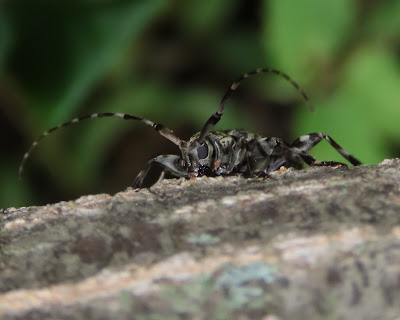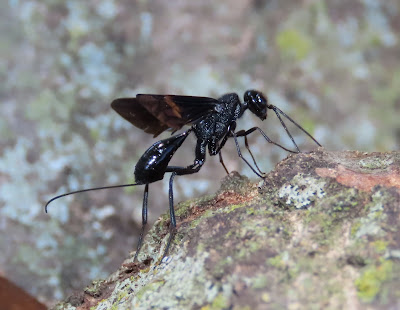Sometimes an unfortunate event yields something interesting later. More on that in a minute. Aulacid wasps are seldom seen, but also often overlooked due to their superficial resemblance to ichneumon wasps. They are found in similar situations as ichneumons, and behave similarly. Two genera and 185 species make up the family Aulacidae, and they collectively occur on all continents except Antarctica. There are thirty-two species in North America.
At 3 AM on June 1, 2022, a massive limb broke off of the Pin Oak tree in our front yard in Leavenworth, Kansas, USA. It apparently hit the ground before striking our house, but it did enough damage to require a new roof and gutters. Removal of the limb took place later that day, and I had the service that did the work leave the log sections in a pile around the base of the tree, where they sit currently. The least I could get out of this minor tragedy would be some interesting insects.
Cut, living wood emits aromatic compounds that attract insects eager to exploit the resource. These include wood-boring beetles in the families Cerambycidae (longhorned beetles), and Buprestidae (jewel beetles or metallic wood-boring beetles) that lay their eggs in bark crevices. The beetle larvae that hatch then bore into the wood. In turn, the parasitoids of these beetles arrive. Aulacid wasps are known to be parasitoids of these beetles, especially the larvae of the longhorned beetles, as well as larval wood wasps in the family Xiphydriidae.
I had collected aulacids in Cincinnati, Ohio when I lived there, and those specimens now reside with the rest of my collection at the Denver Museum of Nature and Science. I had not photographed any, except for one specimen of Pristaulacus rufitarsis in Colorado. I had the good fortune of getting permission to look for insects at a slash pile of freshly-cut pine in Black Forest, just north of Colorado Springs.
Here in Kansas, on the western-most fringe of the eastern deciduous forest, I was not sure whether these wasps would occur here. I was delighted to finally spot a female of Pristaulacus fasciatus on the pile of logs in our front yard in late July. Since then, through mid-August, I have seen at least three specimens, and finally managed to get respectable images. All have been females. Perhaps mating takes place away from the logs and trees that the females scour for evidence of their intended hosts.
It has been interesting observing these wasps. They walk haltingly across the logs, bobbing their abdomens slightly, and slowly rowing their wings, which is enough to give one cause to think they might be stinging spider wasps. Indeed, Pristaulacus fasciatus may be part of a small mimicry ring, which I’ll address in a future post.
I notice that the female wasp probes every crack and crevice by inserting her antennae deeply into it, perhaps divining the location of a host that way. Once she locates a victim, she commences ovipositing. Grooves on the inner surface of her hind coxae (basal-most segments, connected directly to her thorax, help guide and stabilize her thin ovipositor as she inserts it.
Aulacids are identified by the attachment of the abdomen high on the thorax, a short “neck” behind the head, and a somewhat sinuous, not straight, ovipositor. The first two characters reveal the relationship of aulacids to ensign wasps and carrot wasps under the umbrella superfamily Evanoidea. Aulacus is the other genus, with species typically a bit smaller than Pristaulacus. Females of P. fasciatus have a body length averaging around 16 millimeters, while males are slightly smaller at 13 millimeters. They are conspicuous insects, easily spotted but only in these unusual situations.
Look for P. fasciatus from eastern Texas and Nebraska eastward, though it appears absent from most of the southeast U.S. and Canada. There is one record in New Mexico on iNaturalist.
Sources: Eaton, Eric R. 2021. Wasps: The Astonishing Diversity of a Misunderstood Insect. Princeton, NJ: Princeton University Press. 256 pp.
Smith, David R. 1996. “Aulacidae (Hymenoptera) in the Mid-Atlantic States, With a Key to Species of Eastern North America,” Proc. Entomol. Soc. Wash. 98(2): 274-291.










No comments:
Post a Comment
Blog author currently unable to reply to reader comments, nor comment himself. Working to resolve this.